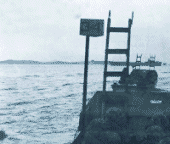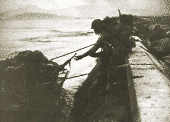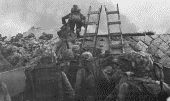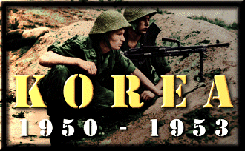The Inchon Invasion

The Inchon Invasion was first brought up in the early weeks of July 1950 when the UN position at the Pusan perimeter was desperate and looked unlikely to hold. Eisenhower's flying visit to Korea on 28th June, three days after he had taken command, convinced him of two things. One; US forces must be committed to hold the Pusan Perimeter, Two; that the best way to take the advantage from the enemy was to stage an amphibious landing in their rear and smash the Communist supply lines. On 4th July, as US Division were beginning to arrive in Korea and the first given date for an amphibious landing was the 22nd July, the attack would be led by 1st Cavalry Division. Planning went ahead, and the date was pushed back to something more realistic, given World War Two experience with large scale amphibious operations. In July there were hardly any of the needed landing craft or ships in Korean or Japanese harbours.
Owing to the increasingly desperate situation on the Pusan perimeter, the operation was abandoned and the 1st Cavalry Division was redeployed to the Pusan perimeter to reinforce the UN forces already there. After some discussion, the landing force was settled on the US 1st Marine Corps Division and the 7th Infantry Division. To support the landings, a massive fleet of ships from the US, British Commonwealth and other UN navies was assembled in South-East Asia. With Inchon chosen as the target due to the proximity of Seoul, the next problem was the 10 metre tidal range of the harbour and the date chosen was 15th September to correspond with a sufficiently high tide to get the Tank Landing Ships into shore, where they could unload their armour.
With the impending operation, diversionary landings took place along the Korean coast to keep the enemy off-guard. Some local landings gained valuable information from the natives about the enemy dispositions around Inchon. This information was relayed back to the planners.
The Invasion

With the UN Forces assembled for the invasion, the diversionary attacks were wound down as air and naval support was directed against the area of Inchon to soften up the enemy in preparation for the landings. By 13th September, the Gunfire Support Group including British Royal Navy cruisers and destroyers, the destroyers (both British and American) moved into the Flying Fish Channel and destroyed mines in a minefield partially exposed in low water before moving on to bombard Wolmi-Do from over 1200m. Counter-fire from North Korean 76mm guns led to only superficial damage to the destroyers and the destruction of the 76mm guns themselves. The destroyers pulled out at 1347 hours, after an hour and a quarter of bombardment.

At 1352, the cruisers laid down a shattering barrage for an hour and a half onto the island with their six and eight inch guns. Carrier aircraft provided air cover throughout the bombardment and also attacked the island. At dusk, the Gunfire Support Group moved out to sea until morning. The pattern was repeated the following day, with some targets in Inchon also being bombarded. As the group withdrew that afternoon, the aircraft providing air-cover reported that the enemy defences on Wolmi-Do were virtually completely destroyed. At midnight, the landing force for Green Beach rendezvoused with the Gunfire Support group and moved towards Flying Fish Channel.

The Invasion craft were circling offshore by 0540 hours, and as the Gunfire Support Group proceeded to flatten the Wolmi-Do island, the invasion craft moved into position. At 0633 hours, the first troops - two Companies of 3rd Battalion, 5th Marines hit the beach and by 0800 hours, Wolmi-Do was secured. Only 17 men were wounded, and none killed. The North Koreans lost 108 dead and 136 captured. Throughout the day, the carrier-based aircraft pounded positions in and around Inchon to prevent enemy reinforcements and assault shipping moved into position through those channels which remained usable at low tide.



